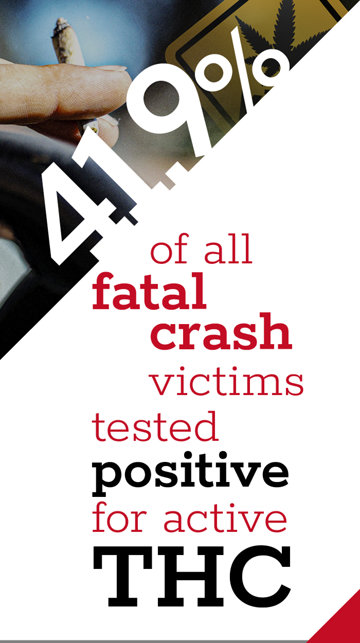The study—led by trauma surgeon Dr. Akpofure P. Ekeh of Wright State University—reviewed six years of coroner records from Montgomery County, Ohio, covering 246 drivers who died in crashes between January 2019 and September 2024. Researchers found that 41.9 percent tested positive for active THC, the psychoactive ingredient in cannabis.
In other words, Dr. Ekeh and his team found that 103 of the 246 deceased drivers tested positive for THC, representing 41.9 percent of all fatal crashes reviewed.
“No form of cannabis use is safe before driving.”
“I was surprised to see that level,” he said, explaining that the drivers who tested positive had an average level of 30.7 nanograms of THC per milliliter—a level that “generally means those people must have consumed marijuana at some time close to driving.” Added Dr. Ekeh: “This isn’t about residual use; it’s about recent consumption.”
To put those numbers in perspective, most states define impairment at just two to five nanograms per milliliter. The average level detected in the study was therefore roughly six to 15 times higher than what the law typically considers unsafe, according to the American College of Surgeons.
Researchers emphasized that the levels measured by the county coroner were drawn within hours of death, providing an accurate picture of each driver’s condition at the time of the crash.

When Ohio legalized recreational marijuana in 2023, policymakers hoped that regulation and education would reduce dangerous use. Yet the new analysis found an increase—albeit minor—before and after legalization: 42.1 percent of deceased drivers tested positive for THC pre-legalization compared with 45.2 percent afterward.
“The messaging over the last few years has been just the push towards recreational legalization,” Dr. Ekeh said. “The problem is that from a public health standpoint, there has not been enough emphasis on some of the downsides and the dangers that can occur. People should treat smoking marijuana just like they treat alcohol: Don’t smoke and drive.”
Other medical specialists echoed the warning. Dr. Laura Markley, medical director of addiction services at Akron Children’s Hospital, told Fox News Digital that even small amounts of THC can diminish alertness and interfere with sound decision-making.
“THC slows reaction time, clouds judgment and dulls coordination—and those few seconds of delay can be the difference between a near-miss and a fatal crash,” she said. “Emerging research shows that any amount of THC can impair driving, and the growing strength of modern cannabis products may make that impairment worse or last longer.”
Dr. Markley added that even frequent users who believe they’ve built up tolerance are not immune—their reflexes and decision-making remain dulled. “The trend toward higher potency reinforces a simple truth,” she cautioned, explaining that “no form of cannabis use is safe before driving.”
The Ohio data reflect a broader nationwide pattern: Cannabis-related traffic deaths have been steadily rising for more than a decade. A 2022 analysis by the Insurance Institute for Highway Safety found that states with legalized recreational marijuana saw a 6 percent increase in injury crashes (collisions causing non-fatal injuries) and a 4 percent increase in fatal crashes following the start of legal retail marijuana sales. Another study published in International Journal of Drug Policy tied legalization to roughly two additional deaths per billion vehicle miles traveled.
At a time when cannabis has gone mainstream, its risks behind the wheel remain stubbornly—and disconcertingly—underplayed.
Meanwhile, federal crash data from the National Highway Traffic Safety Administration’s Fatality Analysis Reporting System show that cannabis involvement in fatal crashes rose from about 9 percent in 2000 to more than 21 percent in 2018.
Experts caution, however, that testing positive for THC does not automatically prove impairment. THC is stored in fatty tissues and can be released back into the bloodstream days or even weeks after use, and postmortem concentrations can vary. But researchers note that the extraordinarily high averages in the Ohio study are hard to dismiss as residual traces. They indicate consumption likely within an hour or two of the crash.
Unlike alcohol, cannabis impairment is notoriously difficult to measure at the roadside. There is no reliable “THC breathalyzer,” and tolerance levels vary widely between occasional and chronic users.
Some states have opted for zero-tolerance laws, while others rely on impairment-based laws that require prosecutors to show observable signs of debilitation documented by officers rather than a numeric THC threshold.
This ambiguity has complicated enforcement and policymaking alike. Public health advocates argue that, until testing improves, education must fill the gap.
Independent experts point to several areas requiring urgent attention:
- Public awareness: Messaging around cannabis-impaired driving hasn’t kept pace with legalization. The Wright State University study underscores the scope of the problem, while national organizations such as the AAA Foundation for Traffic Safety and the Governors Highway Safety Association (GHSA) warn that many users underestimate cannabis’ impact on coordination and reaction time. GHSA calls for sustained, visible campaigns comparable to the nation’s long-running “Don’t Drink and Drive” efforts.
- Better testing technology: The development of saliva-based roadside devices and eye-tracking systems that can detect recent cannabis use more accurately than traditional blood or urine tests is underway. Pilot projects in several US states and university labs show progress toward identifying real-time impairment, though standards remain under review.
- Education and awareness: The Foundation for a Drug-Free World, an international nonprofit supported by the Church of Scientology, operates one of the largest global education campaigns on substance abuse. Its Truth About Drugs program provides educators, parents and youth with factual materials—booklets, documentaries and public service announcements—distributed in some 20 languages across more than 180 countries. The program’s lessons emphasize that even so-called “soft” drugs like cannabis can impair coordination, distort perception and erode self-discipline—risks that young people and first-time users often underestimate. By promoting informed choices rather than scare tactics, the foundation equips communities as well as organizations, government agencies and law enforcement to address drug misuse through education and early prevention.
At a time when cannabis has gone mainstream, its risks behind the wheel remain stubbornly—and disconcertingly—underplayed. The Ohio data may be local, but its warning is universal: As access expands, prevention has lagged far behind.
Until campaigns, enforcement and science catch up, the message from the operating rooms of Dayton to the coroner’s labs of Montgomery County remains the same—don’t drive high.






















